
by Mary Caperton Morton Tuesday, May 5, 2015
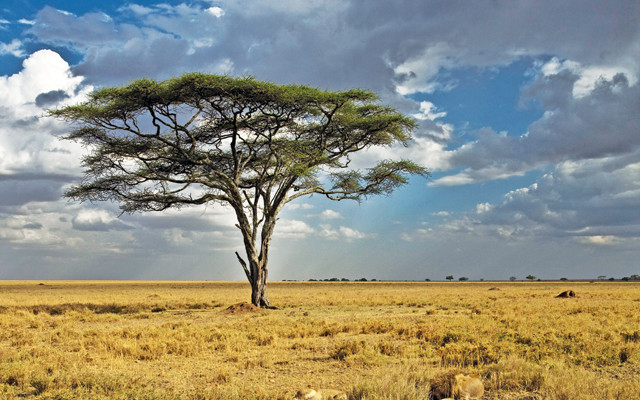
Grasslands in Tanzania's Serengeti National Park in East Africa may be similar to some of the habitats in which early humans evolved. Credit: ©Noel Feans, CC BY-2.0.
Paleoanthropology has traditionally been a dusty science, with new discoveries usually involving bones, teeth and stone tools painstakingly picked from the dirt. But in recent years, the field has embraced a more integrated approach to understanding our ancestors, studying them not just in terms of their skeletons and artifacts, but also their biology and behavior as formerly living, breathing organisms.
This new approach to the study of human evolution, which combines paleoclimatic and isotopic data along with comparative anatomy and behavioral studies, is updating the narratives of many stories anthropologists have long told about our ancestors, and creating a more detailed, holistic picture of early hominids and the ever-changing landscapes they inhabited.
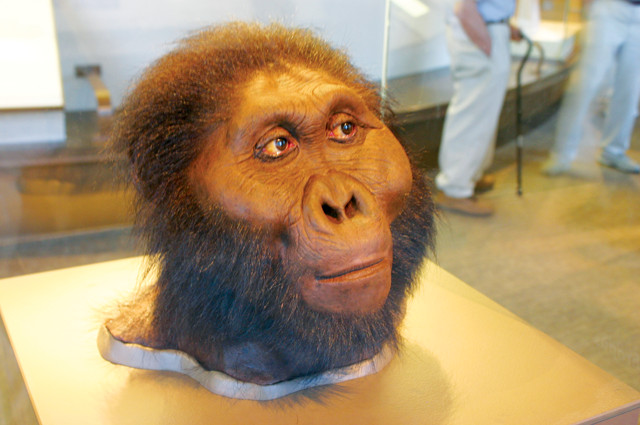
A facial reconstruction of Paranthropus boisei at the David H. Koch Hall of Human Origins at the Smithsonian Natural History Museum. Credit: ©Ryan Somma, CC BY-SA 2.0.
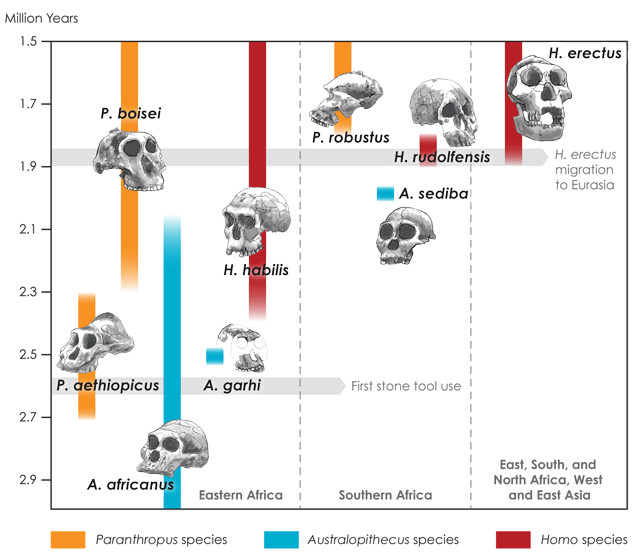
Several taxa of hominin existed contemporaneously between 3 million and 1.5 million years ago, which reflects different strategies of adaptation to habitat variability, according to new research. Credit: K. Cantner, AGI, after Antón, Potts and Aiello, Science, 2014.
“In anthropology, we’ve been moving away from the idea that human evolution is just bones and stones and who’s related to whom, and have really been focusing on putting flesh on our ancestors,” says Leslie Aiello, an anthropologist with the Wenner-Gren Foundation, which was founded in 1941 to support anthropological research into human origins. “One of the real welcome trends in the field has been integrating other lines of study … to give us a much richer understanding of early humans.”
Each year, Wenner-Gren gives out grants totaling about $5 million. Because “we see so many [grant] applications, we have a fairly good idea of what’s going on in the field,” Aiello says. Overall, she says she has noticed more projects involving collaborations, not just between anthropologists and geologists, but also among scientists from other fields.
“Now, we’re seeing more projects that incorporate broader aspects of human biology, such as the relationship between diet and brain development or the role of fat in energy storage,” she says. “Each year, we’re seeing more and more creative and interesting hypotheses.”
In the past few years, comparative anatomy and behavioral studies have added tremendous insights into who our ancestors were and how they lived.
“New fossils are hard to come by, so when you do get a great, iconic piece, you want to know the whole story about it; and we’ve gotten very good at telling stories based on tiny bits of bone,” says Susan Antón, an anthropologist at New York University. “But there’s a tendency to think that the fossil you have is typical of the whole species, and you forget about things like natural variation.”
That’s where comparative studies using modern humans, apes and other animals can help inform the picture of early hominids, Antón says. A modern perspective “gives you more of an innate understanding about how much variation is possible within a species,” she says. “Just because this bit of bone is different from that bit of bone doesn’t necessarily mean you have two separate species.”
To close the gap between researchers studying early humans and those studying living modern organisms, Antón and her colleague Josh Snodgrass, an anthropologist at the University of Oregon in Eugene, formed a collaboration called the Bones and Behavior Working Group in 2007. The group tries to tie together how skeletal structures relate to different behaviors.
Snodgrass says that, initially, the goal of the Bones and Behavior group was to facilitate communication among scientists working in different fields. “As a graduate student I couldn’t understand why anthropologists didn’t spend more time talking to biologists who study living human populations. There seemed to be some disconnect there,” he says.
Additionally, when studying living organisms, biologists often don’t focus on skeletal structure because they have the full specimen right in front of them, Antón says. “So a lot of times those connections [between biology and behavior] don’t get made.”
Part of the disconnect is also likely due to the tendency of scientists to specialize heavily in one particular area of study, Snodgrass says, which can have a limiting effect on interdisciplinary collaboration. “People who were studying paleoanthropology weren’t thinking about living human populations, and people who were studying living human populations weren’t thinking about how their work could apply to anthropology,” he says. But these disciplines are “so much more powerful when you integrate” them.
In addition to hosting annual meetings to bring specialists from various disciplines together, Bones and Behavior also develops standardized protocols for comparing living organisms like apes and monkeys to early humans. “For example, if you want to compare nonhuman primates to each other and then to humans and hominid fossils, there needs to be one systematic protocol for taking those measurements. But until we developed a protocol, nobody had bothered to standardize that kind of work,” he says.
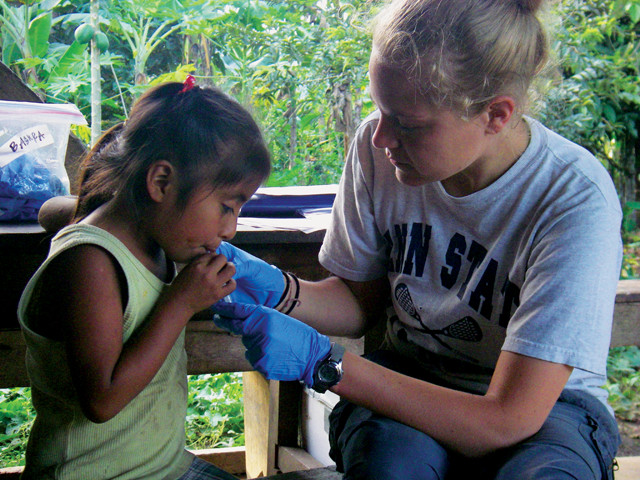
Studies of modern populations may reveal insights into early human evolution. Credit: Josh Snodgrass.
Such protocols are freely available through the Bones and Behavior website. “Not only has this given people the tools they need to create data sets that everybody can use, it has also opened researchers’ eyes to the kinds of data we need,” Snodgrass says.
For example, a team from the University of Wisconsin at Milwaukee that darts and tags vervet monkeys in South Africa to aid in tracking populations and wildlife conservation efforts was inspired by the Bones and Behavior protocols to start taking standardized measurements so that other researchers could study how changing climates affected body size in monkeys — information that may eventually factor into studies of early humans.
More collaboration between biologists and anthropologists may also lead to discoveries in evolutionary medicine, Snodgrass says. “Evolutionary medicine brings together quite a few different specialties, including anthropologists, but also physicians, physiologists, nutritional scientists and biologists, among others.”
One recent evolutionary medicine project looked at bone density — which is affected by diet and life history events like menarche, pregnancy, lactation and menopause — among indigenous populations in Ecuador and Bolivia. “Most of what we know about bone density is based on contemporary populations living in the U.S. We know virtually nothing about the rest of the world, let alone ancient humans,” he says. The study found that the tribes, described as forager-horticulturalists, had higher bone densities and less severe osteoporosis on average than Americans. “That may tell us something interesting about our ancestors.”
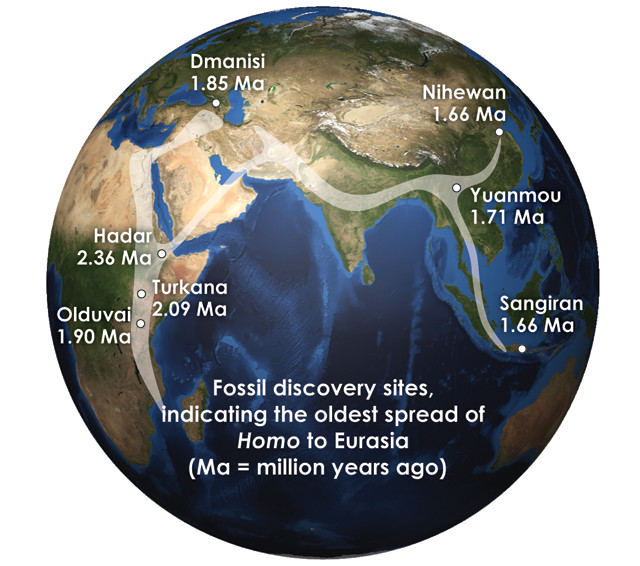
A new integrative approach to paleoanthropology is rewriting the story of the evolution and migration of the Homo lineage. Credit: K. Cantner, AGI, after Antón, Potts and Aiello, Science, 2014.
“Over the whole range of human evolution, Earth has experienced tremendous fluctuations in climate,” Aiello says. “It probably was not an accident that humans arose during one of the most climatically volatile periods in the history of the Earth. Not everything was determined by climate, but it’s always in the background.”
This idea of climate driving human evolution isn’t new. The traditional tale, told for decades now, is that increasing aridity led to an expansion of open grasslands, which forced our ancestors out of the trees and onto the ground, where they became bipedal.
“That’s a nice story, but when you consider all the data, it points to a much more complex narrative,” says Richard Potts, the curator of anthropology and director of the Human Origins Program at the Smithsonian Institution’s National Museum of Natural History.
Some paleoclimate proxies, such as records of aeolian dust and carbon isotope ratios in soil carbonates, tell one story — one of progressive drying in Africa around the time that the first hominids were diverging from other apes — while other proxies, such as lake sediment cores, point to more variability, with alternating periods of wet and dry, Potts says.
“Some kinds of [proxy] data are preferentially preserved when you have really dry periods and other kinds when you have really wet periods,” Antón says. “If you only look at one kind of data set, which has been the approach taken in the past, it can really skew your picture of a place at a certain time. But when you look at all of the data sets collectively, the variation in the [climate] signal jumps right out,” she says.
Last July, Antón, Potts and Aiello published a review study in Science that incorporated paleoclimate data, fossils and comparative biological studies covering a wide range of mammals, including modern humans. The intent was to examine how early human ancestors might have coped with varying environments, starting around 6 million years ago.
The lesson that emerged was not that humans had to find ways to cope in a drier world, but that they needed to be flexible in order to adapt and survive in environments that were constantly changing, Potts says. That change helped shape a species that was able to make a living in many kinds of habitats and exploit many different sources of food — a species that eventually went on to occupy all corners of the globe.
“Unstable climate conditions favored the evolution of the roots of human flexibility in our ancestors,” he says.
Potts first proposed his variability hypothesis in the 1990s, but the 2014 Science paper brought together many lines of evidence in support of the theory.
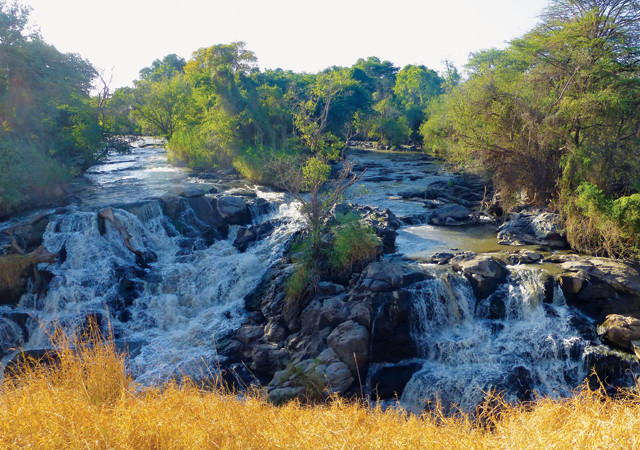
Several important hominid fossils have been found near the Awash River in Ethiopia's Afar Depression, as well as some of the oldest Oldowan stone artifacts. Credit: ©Ji-Elle, CC BY-SA 3.0.
For example, according to paleoclimate records, the period from about 2.5 million years ago to 1.5 million years ago was a time of strong climate instability and shifting intensity of annual wet and dry seasons. This time period also saw the greatest number of coexisting hominin species living at one time in Africa, including Paranthropus aethiopicus, P. robustus, Australopithecus africanus, A. sediba, Homo habilis, H. rudolfensis and H. erectus.
The variability hypothesis helps explain why so many species of early hominids appear to have overlapped in time and place: each may have been able to exploit certain environments, with some species best exploiting available resources in wet conditions and others in drier conditions. “There was a fine line between thriving and decline for any given population of hominids,” Potts says. “And of course, many became extinct.”
The species that were able to adapt to both wet and dry conditions were likely the most successful, Potts says. “Almost every milestone in human evolutionary history corresponds to one of eight prolonged periods of high climate variability,” he says. “The first appearance we have in the archaeological record of every single major [tool-making] technology — Oldowan and Acheulean, Middle Stone Age, Late Stone Age — occurs in a period of prolonged high climate instability.”
In addition to species diversity and stone tool technology, the Science study also compiled data on changes in body and brain size, dentition, tool making, and stone transport, which reflected cognitive evolution and changes in diet, for example.
The study highlights the strengths of the new, more collaborative anthropology, says Naomi Levin, a geologist at Johns Hopkins University in Baltimore. It “shows how we’re transitioning away from thinking about [the climate of] early humans in such simple terms as wet and dry, and moving towards understanding the system as a whole.”
As the field of anthropology becomes more integrative, it is changing how scientists work.
“In order to keep working on new theories and new approaches, we need to bring people who don’t normally work together into the same room,” Antón says. In one Wenner-Gren Foundation meeting in 2012, “we had people who study climate; we had people who study how apes expend energy; we had people interested in diet. We even had a wildlife biologist who studies the behaviors of social carnivores to help us think about how early humans might have worked together to survive. It was an incredible meeting of the minds,” Antón says.
The next step in anthropology will be to welcome even more complexity to the narrative of early humans, Levin says. “Some people complain that more fossils or data makes things more complicated, but it’s a complex world and we shouldn’t expect simple answers.”
Many of the questions that remain about our ancestors will probably be answered not with fossils, but by the new multidisciplinary approaches. “We need to step it up and do more state-of-the-art analyses with the latest technology being used by biologists,” says Herman Pontzer, an anthropologist at Hunter College in New York City. Scientists won’t get the answers they seek by “just relying on the same old methods we’ve always used in anthropology.”
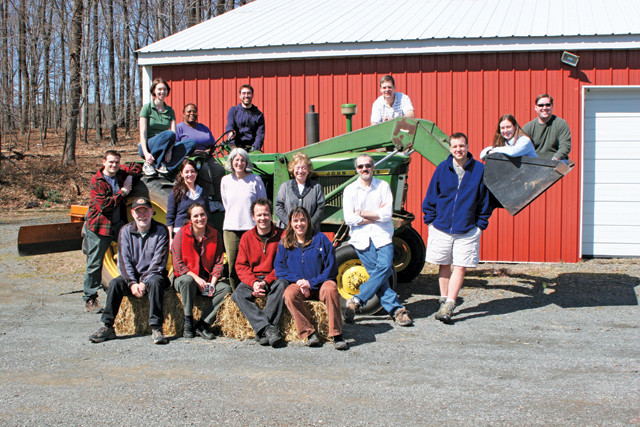
The Bones and Behavior Working Group hosts annual meetings of specialists from various disciplines to facilitate collaboration. Credit: Josh Snodgrass.
In addition, the field of genetics, which can reveal evolutionary relationships on the molecular level, is contributing a more technological approach to studying human evolution, Aiello says. “Genetics has some very exciting applications in our field. It’s giving us a much broader base for interpreting what was going on in the hominid family tree.”
The future of the field will ultimately lie in the hands of today’s graduate students, Aiello says. “We have a number of young people working quite enthusiastically on more integrated approaches. They have such unique and diverse ways of thinking about the world. That’s where change will continue to come in our field.”
© 2008-2021. All rights reserved. Any copying, redistribution or retransmission of any of the contents of this service without the expressed written permission of the American Geosciences Institute is expressly prohibited. Click here for all copyright requests.